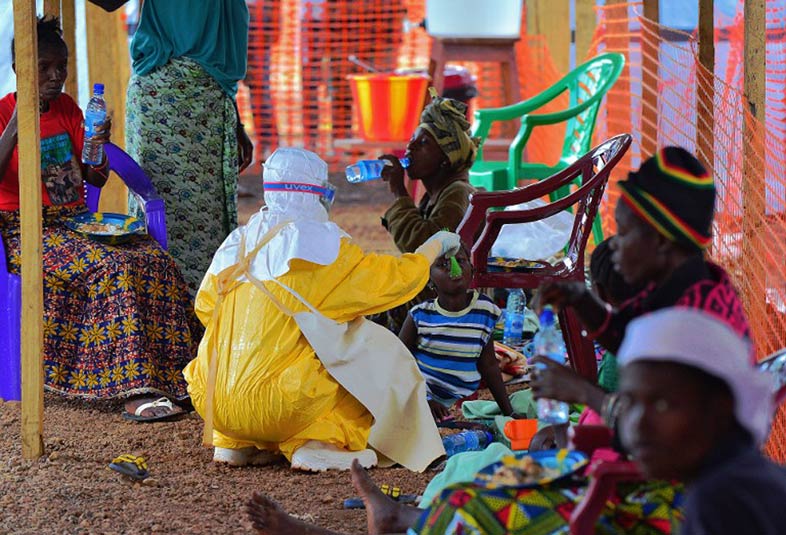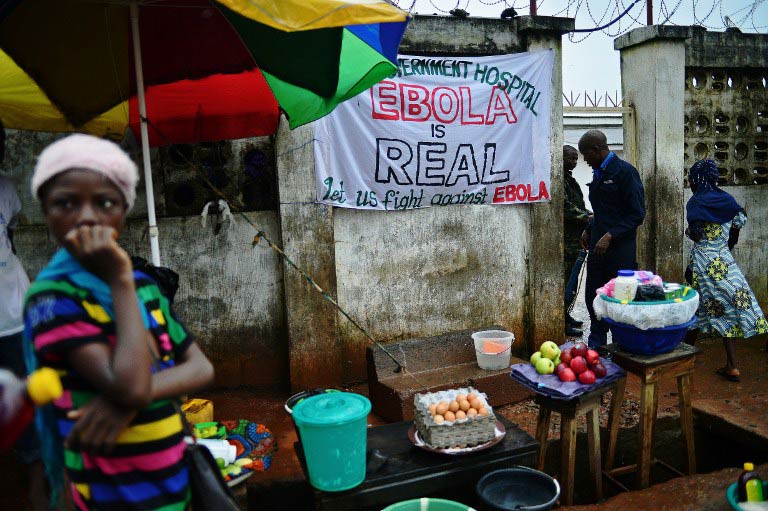
Hawa Idrisa was visiting her father-in-law in an Ebola ward in eastern Sierra Leone when his drip snapped out and his atrophying veins spurted thin, uncoagulated blood into her eyes and mouth.
She had been carrying her infant daughter Helen but luckily she had laid the child down, otherwise the baby would almost certainly be dead by now.
A single droplet of blood smaller than a full stop can carry up to 100 million particles of the deadly Ebola virus, yet one is enough to end a human life.
“The blood got all over me, and people were running away. So I took a bucket of chlorine and poured it over myself,” Hawa said.
She returned home to forget her ordeal, but a week later she began experiencing fever and headaches, the early symptoms of the Ebola.
Her 12-month-old mercifully tested negative, but her husband Nallo was infected and he and Hawa checked into the Doctors Without Borders’ (MSF) treatment facility in the eastern district of Kailahun.
Hawa spent four weeks drifting between life and death at the centre, in the district capital Kailahan city, a trading post of 30 000 in the Kissi triangle linking to Liberia and Sierra Leone.
“I didn’t know what was happening to me. I didn’t even know where I was. I don’t remember anything from that time,” she told AFP of the ordeal she survived.
Ebola kills more than half of the people it infects, putrifying their insides in the worst cases until their vital organs seep from their bodies.
It is highly infectious but not particularly contagious, meaning that once you are exposed, your chances of escaping the fever are extremely low, although it can only be passed on through bodily fluids.
The good news is that when patients are caught early enough, given paracetamol for their fevers, kept rehydrated and nourished, their chances of survival increase dramatically.
Hawa proudly shows off a certificate saying she has recovered fully, and she is preparing to return home.
“I know there is nothing wrong with my daughter, but my mind and heart will be at the centre with my husband,” she says.
Hardest-hit districts
Already more than 2 100 people have been infected across four west African countries, and 1 145 people have died, dwarfing previous Ebola outbreaks.
The epidemic is perhaps worst of all in Sierra Leone, which has registered 810 cases, more than any other country.

The hardest-hit districts, Kailahun and the diamond trading hub of Kenema next door, have been sealed off to ordinary members of the public.
Around a million people in the two districts are in effective lockdown, and locals say soaring food prices are pushing the region towards a crisis.
Local doctors and nurses are fighting not just the disease, but also the distrust of locals who fear modern medical practices.
Relatives have been known to snatch infected loved-ones from clinics to die in their own villages, exacerbating the spread of the virus.
They have even attacked treatment centres – as armed men did in neighbouring Liberia at the weekend – convinced that Ebola is a Western conspiracy against traditional African communities and that foreign healthworkers are in on the secret.
Some 1 500 police and soldiers have been deployed to prevent raids, but they are powerless faced with the suspicion and fear of poorly educated traditional communities.
Many tribespeople at the epicentre of the outbreak either don’t know how to prevent and treat Ebola or do not believe it exists at all.
This, says MSF, is where the survivors come in.
Survivors returning home
Ella Watson-Stryker (34), a health promoter with the aid agency, is part of a team taking Hawa and other survivors home to their villages.
She will gather their neighbours and family members around, answer their questions about the virus and try to reassure them that Hawa poses no danger.
“This is very exciting for us. It’s also really beneficial to the overall response to the outbreak because when survivors go home, they can explain about their stay at the centre.
“They give people hope that it is possible to survive and it really builds trust between the community and MSF,” she says.
Watson-Stryker also says that when survivors go back to their communities, people begin to understand that treatment centres are not just “a place where people go to die”.
They are surprised to learn that patients are fed, given unlimited soft drinks, access to toilets, showers and medicine, and that their families are encouraged to visit.
“We try to assuage the fears of the community, because there are a lot of rumours out there, that as soon as you come to the treatment centre you will just be left to die.”
Back at the MSF centre, Nallo enthuses about his future with Hawa and their baby girl, despite remaining in grave danger in the high risk area.
“At first people thought that when they got here, they were going to have all their blood removed and they would die,” he says.
“They have been giving me drugs and I am much better, so when I get back to my community I will tell people that if it ever happens that they get Ebola we advise them to come here.”
